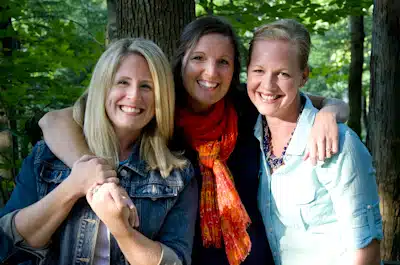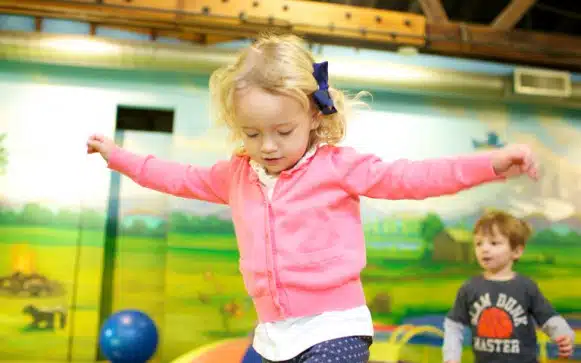I sometimes felt silly singing songs and performing classroom activities with my daughter when she was baby, but now, as an early childhood music teacher, I realize that there is a method to the madness behind these exercises.
These early activities not only help your baby to reach a multitude of developmental goals, but also serve to introduce your child to his world and consequently, how to navigate his place in it. Early movement and exploration triggers your child’s natural development of spatial awareness.
This important term is very broad, thus, we asked the pediatric therapists and moms of The Inspired Treehouse blog to share their bright expertise below:
What is Spatial Awareness?
“Spatial awareness is how a child senses his body in relation to his physical surroundings. It may seem simple enough, but this skill actually relies on a complex interaction between the body’s sensory systems.
- (1) A child’s visual system helps him perceive his physical surroundings using sight, or, what he sees.
- (2) The vestibular sense is centered in the inner ear and gives child information about the position of his head and body in space.
- (3) Proprioception refers to the way joints and muscles send messages to the brain to help coordinate movement.
When these sensory systems are working together properly, a child is able to move smoothly and navigate even the most complex environments (ex: climbing, sliding, balancing, swinging at the playground). He can react quickly to changes in his environment (e.g. avoiding other children in a game of tag) and understands concepts like near and far, right and left, up and down.” — The Inspired Treehouse
Infants & Crawlers: Within a baby’s first classroom experience at Bubbles Academy, we nurture the use of the visual, vestibular (balance) and proprioceptive systems —and you can at home too!
Song: Even when upset, young babies are born equipped to respond to pleasant sensory experiences — the sight of a parent/teacher’s smiling face or the sound of a soothing lullaby. This unconscious body sense is the first sign of emerging spatial awareness, and assists babies to orient themselves in relation to surrounding people and objects.
Finger-plays: An infant’s first introduction to their body can be accomplished through the use of finger-plays. Simple songs such as “Head Shoulders Knees and Toes” provide baby with an early understanding of the location/relationships of his body and limbs through the gentle touch and rhythmic tapping from the parent.
- Babies visually discover their body when they notice their hands. Clapping songs and finger-plays develop proprioception — the ability to sense their body’s orientation, limb movement and the effort being used to make these movements such as kicking, clapping and waving.
Tummy Time and Bouncy Songs: Sung bouncy songs such as “I’m a Little Tea Pot” and other traditional tummy time songs are helpful distractions, plus, they both engage and encourage baby to hold different body positions (which offer new viewpoints).
Instrument Play: Small instruments are wonderful tools to gain proprioception. As babies hold, shake, examine and bring the instruments to their mouths to explore, the nerve endings in their joints and muscles are busy sending messages to the brain, coordinating muscle control and movement.
Movement Games: We encourage crawling babies, with their unique and new perspective of being on all fours, to move throughout the classroom. With the use of puppets and other enticing props, you can initiate exploration and spatial concepts such as distance.
Walkers & Toddlers
Within Walkers & Toddler classes, we see the cooperation between the sensory systems emerging in children — smoothly navigating, avoiding obstacles, and understanding “concepts like near and far, right and left, up and down.” The spatial awareness activities we implement in class can be held live in your own living room too!
Creative Movement, Music and Ballet classes introduce the concepts of direction, distance and location.
- As children move across the floor, they begin to understand how each step brings an object in their viewpoint closer, while objects behind them appear smaller.
- Various musical moods and styles help develop balance and timing.
- While engaged in activity & play, your child will begin to appreciate the space around himself and the proximity of others around him.
Clean Up Time: Clean up time is a favorite activity for most toddlers. Putting objects in and out of containers helps them to understand spatial relationships, such as in, out, full, and empty.
A natural question in regards to this topic — what happens when the sensory systems are not working together properly (visual, vestibular, proprioceptive)? The pediatric therapist team of The Inspired Treehouse enlightens …
Problems with Spatial Awareness
“When a child has difficulty with spatial awareness, he may appear clumsy and uncoordinated, frequently tripping and falling or running into objects. He may struggle during interactions with other children, having difficulty maintaining his own body space while standing in line or moving through a crowded hallway.
This child may not have a solid understanding of spatial concepts, impacting his ability to follow directions during movement activities. He may even struggle with visual motor tasks like handwriting, drawing, and coloring — not leaving any space between his words (or leaving large spaces), or having difficulty keeping writing and coloring within the lines.” — The Inspired Treehouse
The spatial awareness activities below are robust, interactive gross motor challenges for children (we definitely champion for our age 3 to 5 students)
Spatial Awareness Activities recommended by The Inspired Treehouse
“One of the most popular posts at The Inspired Treehouse has been a group activity for kids called Rabbit Hole. This is an awesome way to give kids exposure to a variety of spatial awareness tasks, including navigating obstacles and maintaining awareness of how your body is moving in relation to the people around you.”
More favorites:
A sounding lesson I have learned as a mom and a teacher, and is a true pillar of The Inspired Treehouse: support your child as they jump, roll and run — PLAY — so that he can learn about his body, spatial relationships and his role within the world.
From tummy time as an infant to hula hooping as a 5 year old, your child will be reaching towards a myriad of complimentary developmental milestones including muscle strength, coordination, self-confidence, and independent thinking. — Kim
Questions on spatial awareness activities or care to share experiences that have helped your child make way (sometimes with grace), but more importantly, with ease — tweet @BubblesAcademy & @inspiredtree.
- The Bright Move: This post is a part of a collection of blogs leading into Fall 2014. The thoughtful, bright moves Bubbles Academy takes in the classroom and recommends for at-home, feature explorative play & arts based activities — encouraging healthy physical, cognitive and social development for your child. Like this post? Share with the hashtag #thebrightmove


Guest Authors: Pam, Lauren, and Claire are the creators of The Inspired Treehouse, a blog that’s centered around the belief that with a little help, kids can build strong, healthy bodies and minds through play. They are pediatric therapists and moms who are passionate about creating activities and sharing knowledge to promote development and wellness in kids.
